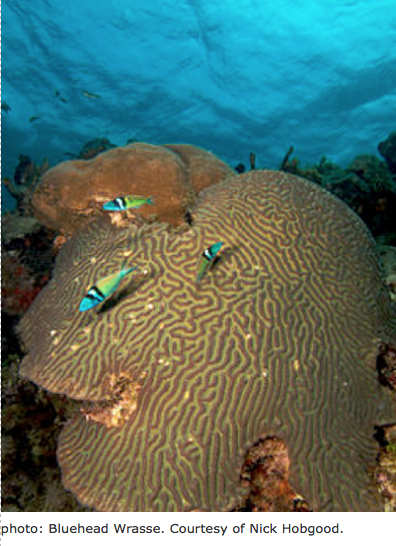Coral Reef Opera
From JeffCorwinConnect Citizen Blog:
If you ever wanted ideas for a new soap opera, coral reefs would be the place to go.
These colonies of tiny living animals not only provide vital ecological services, such as protecting shorelines, but are also home to some of the most diverse-and strange-creatures on the planet.
Dive a few meters below the surface and you’ll meet a cast of characters that could rival those on Melrose Place. Similar to that fictional locale, the life of coral reef fish centers around sex, or, more accurately, tactics for successful reproduction necessary for the continuation of their species-referred to as “life history strategies.” For some, these strategies go as far as changing gender.
Coral reef fish “have got every trick sewn up,” says Steve Simpson, Senior Researcher at the University of Bristol’s School of Biological Sciences. A good example is the clownfish, of Finding Nemo fame. Clownfish may end up either male or female. When young, they have no gender. They may spend years in their anemone home waiting to get a shot at adulthood. And then it depends on what’s needed. If the female (who is larger than the rest) in the colony dies, the biggest male will become female in order to replace her. That strategy, called sequential hermaphroditism, makes sense.

Clownfish live inside sea anemones, which provide protection and food for their guests. In return, the clownfish benefit their hosts by helping to lure food to the anemone, polishing off uneaten food particles and keeping the anemone free of dead tentacles. Clownfish rarely stray far from home. While their limited mobility could restrict mating opportunities, they make sure they have everything they need within the colony, changing sex to maintain the right gender balance, and optimizing output of the next generation.
Many wrasse also change their sex. Depending on the species, wrasse typically start life as females and later become males, in what’s called their terminal phase. Yet wrasse have an additional ability: they can change their appearance. When it will enhance their success with the ladies, inferior males will “cross dress” to imitate the opposite gender.

Wrasse live in harems where a dominant, terminal male controls a territory with multiple females. Often, this dominant male displays distinct colors and patterns to set it apart and thus hinder the prospects for the other males to breed. Yet that strategy doesn’t stop the less dominant males. Instead, these other males might “dress up” as females by putting on the same colors and swimming around with the females as they wait for mating opportunities. This “sneaking,” or looking for a lucky break when the terminal male drops his guard, is worthy of the most devious soap opera star. Watch for it in the next script.
